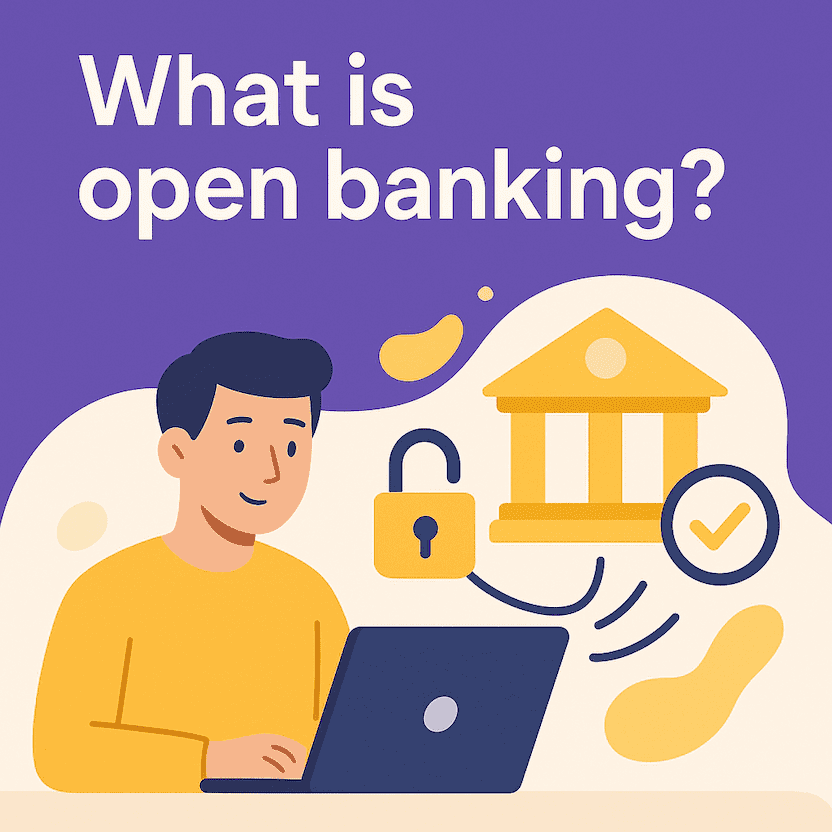Advertiser Disclosure
Last update: September 19, 2025
9 minutes read
What is Open Banking? How Students Access All Their Accounts in One App
Ever wish you could see all your bank accounts in one place? Open banking makes it possible, giving students smarter ways to manage money across multiple financial institutions.

By Derick Rodriguez, Associate Editor
Edited by Yerain Abreu, M.S.
Learn more about our editorial standards



By Derick Rodriguez, Associate Editor
Edited by Yerain Abreu, M.S.
Learn more about our editorial standards
Have you ever tried juggling multiple banking apps just to check your checking account, savings, and student loan balances? Open banking might be the solution you didn't know existed.
This financial technology allows you to securely connect all your accounts to a single platform, giving you a complete picture of your finances without the app-hopping marathon.
Whether you're tracking spending across different banks or trying to get a handle on your overall financial health, open banking puts the power back in your hands. Here's everything students need to know about this technology and how it's changing the way we manage money.

Key takeaways
- Open banking lets you securely share your financial data with third-party apps and services
- Students can view accounts from multiple banks in one dashboard, making budgeting easier
- You control which apps can access your data and can revoke permission anytime
What is open banking?
Open banking is a system that allows third-party financial service providers to access your banking data through secure application programming interfaces (APIs). Think of APIs as digital bridges that let different software systems talk to each other safely.
Instead of logging into five different banking apps to check your Chase checking account, Wells Fargo savings, and Discover credit card, open banking lets you see everything in one place.
The "open" part doesn't mean your data is freely available to anyone. You specifically choose which companies can access your information.

TuitionHero Tip
Open banking originated in Europe with regulations like PSD2, but it's growing rapidly in the United States through voluntary adoption by banks and fintech companies.
The technology works because banks create standardized ways for approved third parties to request your account information. When you give permission, these apps can pull data like account balances, transaction history, and spending patterns.

How open banking works for students
For college students managing multiple financial accounts, open banking simplifies money management in several ways:
- Account aggregation: Connect your checking account from your hometown bank, your new college town credit union account, and any credit cards you have. See all balances and recent transactions in one dashboard instead of switching between apps.
- Automated categorization: Many open banking apps automatically sort your transactions into categories like "textbooks," "dining," or "entertainment." This makes it easier to see where your money actually goes each month.
- Real-time updates: When you make a purchase, the transaction appears in your aggregated view almost immediately. No more wondering if that coffee purchase went through or checking multiple apps to confirm payments.
- Cross-account transfers: Some platforms let you move money between accounts at different banks, which is helpful when you need to transfer funds from your savings account at Bank A to pay a credit card bill at Bank B.
Compare private student loans now
TuitionHero simplifies your student loan decision, with multiple top loans side-by-side.
Compare Rates
Real-world benefits for college students
Open banking makes student finances easier to manage by cutting down on manual work and confusion.
Take Amanda, a sophomore at college: she once spent 30 minutes a week entering transactions into a spreadsheet.
Now, an open banking app syncs her accounts automatically, showing where her money really goes, like those frequent coffee runs between classes.
Student loans also become easier to track, since many servicers integrate directly with these platforms. Balances and payments appear alongside checking and savings, giving students a clearer picture of their financial health.
Scholarship and grant deposits show up instantly too, helping ensure money set aside for tuition isn’t accidentally spent.
Even financial aid verification is smoother. Instead of submitting stacks of bank statements, some schools now let students securely share their account data with a few clicks, saving time and stress.

TuitionHero Tip
Check if your school's financial aid office accepts open banking connections for FAFSA verification. It could save you hours of paperwork.
Real examples of open banking in action
Here are specific ways students are already using open banking technology, often without realizing it:
- Venmo balance integration: When you connect your bank account to Venmo, that's open banking. Venmo accesses your account balance to verify you have sufficient funds before processing payments to split dinner bills with roommates.
- Credit score monitoring apps: Credit Karma and Credit Sesame use open banking to connect to your credit cards and loans. They analyze your spending patterns and payment history to provide personalized recommendations for improving your credit score.
- Student loan refinancing platforms: Companies like SoFi and Earnest use open banking to quickly assess your financial situation when you apply for loan refinancing. Instead of uploading months of bank statements, you can securely share your account data for faster approval decisions.
- Scholarship application platforms: Some scholarship platforms now use open banking to verify financial need automatically. Rather than submitting tax returns and bank statements, eligible students can share their financial data directly through secure connections.
- University financial aid offices: Several schools now accept open banking connections for FAFSA verification. Students at these institutions can link their accounts directly instead of printing and scanning bank statements.
Popular student apps using open banking
- Qapital: Rounds up purchases to the nearest dollar and automatically saves the change. Uses open banking to monitor your spending and transfer small amounts to savings.
- Acorns: Similar to Qapital but invests your spare change. Connects to your bank account and credit cards to track purchases and invest rounded-up amounts.
- Splitwise: While primarily for splitting expenses, the premium version connects to your bank account to automatically import shared transactions with roommates.
- Goodbudget: Uses open banking to automatically import transactions into envelope-based budgeting categories, helping students stick to spending limits for different expense types.

TuitionHero Tip
Many students use multiple open banking apps without realizing they're all using the same underlying technology. Check your bank's connected apps section to see which services currently have access to your data.
Is open banking safe?
Student concerns about sharing banking data are completely valid. Here's what you need to know about open banking security:
- Bank-level encryption: Open banking uses the same security protocols as your bank's own app. Your login credentials aren't shared with third-party apps. Instead, banks create secure tokens that allow limited access to specific data.
- Read-only access: Most open banking connections are read-only, meaning connected apps can see your account information but can't initiate transactions or transfers. They can't spend your money or move funds without separate authorization.
- Permission control: You decide which apps can access your data and which accounts they can see. Want to share your checking account but not your savings? You can set those preferences.
- Revocation rights: You can disconnect any app from your banking data at any time. If you stop using a budgeting app, simply revoke its access through your bank's online portal.
Security Feature | What It Means for Students |
|---|---|
256-bit SSL encryption | Same protection as online banking |
Two-factor authentication | Extra layer of account security |
Regular security audits | Third-party apps must meet strict standards |
No stored credentials | Apps never see your actual login info |
Getting started with open banking apps
Ready to try open banking? Here's how to get started safely:
- Choose reputable apps: Stick with well-known platforms that clearly explain their security measures. Popular options include Mint, YNAB (You Need A Budget), Personal Capital, and Tiller.
- Start small: Connect just one account initially to see how the process works. You can always add more accounts later once you're comfortable with the system.
- Review permissions: Before connecting, read what data the app will access. Some apps only need basic account info, while others might request transaction details going back several years.
- Set up alerts: Enable notifications for unusual account activity. While open banking apps can't initiate transactions, it's good practice to monitor your accounts regularly.
- Regular reviews: Every few months, check which apps have access to your banking data. Remove any services you're no longer using.
Common open banking platforms students use
Several platforms specifically cater to student financial needs:
Platform | Key student-friendly features |
|---|---|
YNAB (You Need A Budget) | Proactive budgeting (“give every dollar a job”); one free year for college students; strong goal-setting tools. |
Personal Capital (Empower) | Free basic version with budgeting + investment tracking; useful if students want to track early investing and net worth. |
Tiller | Syncs accounts to Google Sheets/Excel; customizable templates; ideal for spreadsheet-savvy students. |
PocketGuard | Shows safe-to-spend money after bills/goals; subscription tracking; straightforward for day-to-day control. |
Cleo | Fun, chat-based interface with reminders, savings challenges; gamified approach to money management. |
Opportun (formerly Digit) | Automates small savings toward goals; set-it-and-forget-it style for building savings. |
Lunch Money | Modern, flexible tool with forecasting and multi-currency support; great for international or advanced students. |
EveryDollar | Zero-based budgeting; forces every dollar to have a purpose; structured approach for strict planners. |
Spendee | Visual, collaborative budgeting; great for roommates or group expense management. |
Wally | Multi-currency support is good for international students and expense tracking with a clean UI. |

TuitionHero Tip
Many of these platforms offer student discounts or extended free trials. YNAB provides free access for college students with a .edu email address.

Why trust TuitionHero
At TuitionHero, we help you find the best private student loans by comparing top lenders and breaking down eligibility, interest rates, and repayment options. Whether you need additional funding beyond federal aid or a loan without a cosigner, we simplify the process. We also provide expert insights on refinancing, FAFSA assistance, scholarships, and student credit cards to support your financial success.
Frequently asked questions (FAQ)
Yes, open banking is actually safer than many alternatives students use, like sharing login credentials with roommates or writing down account information. The technology uses bank-grade security and doesn't require sharing your actual banking passwords.
Many student loan servicers now support open banking connections. This means you can see your loan balances alongside your bank accounts, making financial planning easier.
You can easily disconnect your old bank and connect your new one. Your transaction history with the old bank typically remains in the app for reference, but new transactions will come from your current accounts.
Many basic open banking apps are free, funded through partnerships with financial institutions. Premium features like advanced budgeting tools or investment tracking might require paid subscriptions.
No, open banking connections are tied to your individual permissions. Your parents would need your explicit consent and login credentials to access your financial data through these platforms.
Final thoughts
Open banking represents a shift toward more transparent, user-controlled financial services. For students managing multiple accounts across different institutions, it offers a practical solution to staying on top of finances without the hassle of juggling multiple apps and passwords.
The technology puts you in control of your financial data while providing tools that can help you make smarter money decisions during college and beyond. Whether you're trying to stick to a tight budget, track scholarship money, or prepare for post-graduation financial responsibilities, open banking platforms can simplify the process.
Remember, you always have options when it comes to managing your money. TuitionHero is here to help you navigate these choices and find the tools that work best for your unique financial situation. Start small, choose reputable platforms, and take advantage of student discounts when they're available.
Source
Author

Derick Rodriguez
Derick Rodriguez is a seasoned editor and digital marketing strategist specializing in demystifying college finance. With over half a decade of experience in the digital realm, Derick has honed a unique skill set that bridges the gap between complex financial concepts and accessible, user-friendly communication. His approach is deeply rooted in leveraging personal experiences and insights to illuminate the nuances of college finance, making it more approachable for students and families.
Editor

Yerain Abreu
Yerain Abreu is a Content Strategist with over 7 years of experience. He earned a Master's degree in digital marketing from Zicklin School of Business. He focuses on college finance, a niche carved out of his journey through the complexities of academic finance. These firsthand experiences provide him with a unique perspective, enabling him to create content that's informative and relatable to students and their families grappling with the intricacies of college financing.
At TuitionHero, we're not just passionate about our work - we take immense pride in it. Our dedicated team of writers diligently follows strict editorial standards, ensuring that every piece of content we publish is accurate, current, and highly valuable. We don't just strive for quality; we aim for excellence.
Related posts
While you're at it, here are some other college finance-related blog posts you might be interested in.
Shop and compare student financing options - 100% free!

Always free, always fast
TuitionHero is 100% free to use. Here, you can instantly view and compare multiple top lenders side-by-side.

Won’t affect credit score
Don’t worry – checking your rates with TuitionHero never impacts your credit score!

Safe and secure
We take your information's security seriously. We apply industry best practices to ensure your data is safe.
Finished scrolling? Start saving & find your private student loan rate today
Compare Personalized Rates


